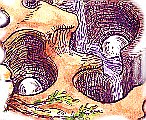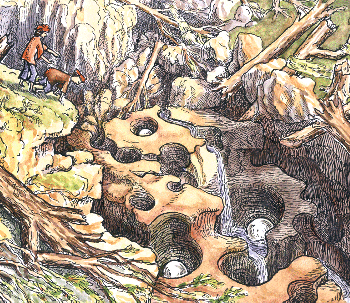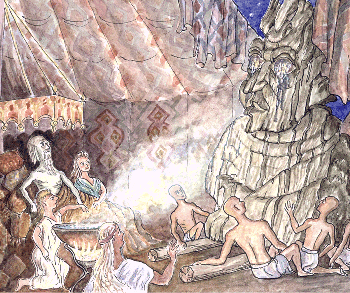
 |
A Himalayan Legend |
Humidity buffering by absorbent materials only works if the buffer and the object to be stabilised are at the same temperature. The consequences of neglecting this rule are dramatically illustrated by a legend from northern India which I stumbled across while sheltering from the rain in the library of a small north German town.
The town archive in Niederbrück holds the notebooks of Dr. Wilhelm Froschfeld, an anthropologist and explorer who disappeared on his seventh expedition to the Himalaya in 1895. This muddled, but fascinating archive has not been published because his widow, concerned about some of the details in his notebooks, had left them to the library with the stipulation that nothing was to be published until 100 years after his death. My own interest was awakened by the illustrations in the notebooks, which he probably used to clarify his interviews with people whose language he hardly knew. Here is the story that I pieced together around a series of sketches made during his journey to a remote mountain valley on the border of India, China and Burma.

In the high valley of the Ramagashana river, a short but turbulent tributary of the Bramaputra, lives the Nangali tribe. They are peacable people, living on fruit and cereals with some fish from the river. They follow an obscure branch of Hinduism, whose material representative is a huge but decrepit statue made of wood but adorned with eyeballs of solid silver. The origin of these eyes is attributed by legend to a great storm. The flood scoured out the bed of the river, revealing the potholes in the bedrock.The astonished peasants discovered the silver spheres in the potholes. The discovery of such riches tested the social stability of the tribe as each family remembered a long established but lapsed ownership of that part of the river. One person, more far sighted that his squabbling kinsmen, patiently worked his way up the river, following the trail of the silver to a huge rock fall, caused by the same storm that scoured out the bed of the river. The storm that had revealed the rich ore deposit had also buried it.
The chief of the tribe decided that the only proper use for the few silver nodules was to enshrine them in a temple devoted to a new god: one who gives and who takes away. The worship of this ambivalent deity re-united the tribe in the hard toil of everyday life in the mountains. The god himself was fashioned of wood with selected parts made of the precious metal. In Froschfeld's time only the upper part of the body remained in the mountaintop temple.

Many years later the king of the tribe fell mortally ill. All the efforts of the medicine men failed to stem the decline in the old man's health. In a last desperate attempt to prolong his life the king asked that the holy image be brought to him so that he could draw strength from its supernatural powers. The vast figure was hastily brought down from its mountain temple to the palace in the valley. The king raised himself to look at the god.The god in turn gazed at the king through the steam and incense laden air of the sick man's chamber. Suddenly tears filled the great silver eyes and dribbled down the dry cracked wood of the face. The king and his attendants gazed with awe at the unexpected display of compassion from a stern and inanimate statue. The king died and a legend was born: that tears from the silver eyes of the god fortold the Death of Kings.
Many years passed. The peaceful kingdom was invaded by a tribe from the north-west, the Vedmagoni, led by a ferocious warrior called Zungbuju. The tribe swept through the undefended valley, chasing the Nangali up into the hills. Zungbuju left them there, not thinking it worth while to risk fighting in unfamiliar terrain to root out the remnants of the swift and cunning Nangali.
The Vedmagoni settled in the valley but it was not long before Zungbuju became hungry for new conquests. There was just one problem: he had no money to pay his troops. He had heard of the silver-eyed statue in the mountains. He had also heard of the legend but dismissed it as superstition. He decided to sieze the silver by deceit. He offered peace talks with the Nangali and asked them, with solemn assurances of safe passage, to come down to their ancestral capital on their traditional feast day. He also asked them to bring the statue.
The coins for the soldiers were to be debased with copper, so Zungbuju ordered a collection of all the copper pans in the valley. A Nangali slave who served the metalsmith became suspicious. Under the pretext of fetching some copper implements from an abandoned hut up in the hills he hastened to warn the Nangali. The message was transmitted to the chief priest, Sedemichra, who immediately prepared to thwart the evil intentions of the king of the Vedmagoni.

This work is licensed under a Creative Commons Attribution-Noncommercial-No Derivative Works 3.0 License.